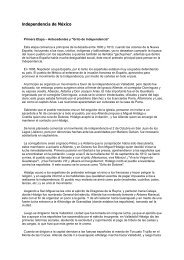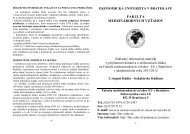usinesses etc.) as well as by long-term stagnating aggregate demand (caused by aging ofpopulation and psychological aspects after the slump in asset prices), including the crisis in thebanking system, insufficiently expansive monetary policy (in the long-term oriented atmaintenance of low inflation). 23 The deflation was also strengthened by JPY appreciation,which reduced prices of imported goods. The continuing decline in prices could also be seen instrong deflationary expectations in the 1990s, which the BOJ was not able to reverse.Figure 3: Price Development in Japan, 1993-2005, average annual changes (%)2.01.51.00.50.0-0.5-1.0-1.5-2.0GDP DeflatorCPIProducer Price Index-2.51993 1994 1995 1996 1997 1998 1999 2000 2001Source: CAO (2006): Annual Report on The Japanese Economy and Public Finance 2006,(CPI, Produce Price Index). OECD Economic Outlook, No. 81, 2007 (GDP deflator); ownconstruction.Impacts of deflation on the economy generally depend on its resources, extend andlength. 24 In Japan the causes of deflation were complicated; decrease in prices was long-termand relatively big. Due to worries about uncertain future, Japanese families started toeconomize on their consumption even more and preferred possession of money in cash. Lowconsumption made the businesses decrease production prices further and limit investments,which worsened their financial situation and ultimately led to the growth in bad debts inbalances of commercial banks because of the growth of bankruptcies in the economy. 25Difficulties of the business sector could be seen in the growth in unemployment and instagnation of nominal wages or even in their decrease. Even other fields experienced the decline23 Baig, T. (2003): Japan´s Experience with Deflation and Associated Costs, p. 42.24 As Baig claims, in case of temporary price declines resulting from the growth in aggregatesupply or productivity, the impacts on the economy needn´t be serious. Deflation as well, if it iscaused by positive external shocks (e.g. decrease in import prices thanks to substantial tradeliberalization) may only represent adjustment and transmission of the economy to a newequilibrium. Negative effects are connected mainly with deflation pulled by aggregate demand.See Baig, T. (2003): Understanding the Costs of Deflation in the Japanese Context, p. 5.25 Unexpected decrease in prices among other consequences worsens the position of debtors;the weath is redistributed from a debtor to a creditor. The value of liabilities in real expressiongrows (nominal value remains unchanged), which may cause problems with their settlement.However, in the same time the value of mortgages in the hold of creditors decreases. Thisdecrease may significantly be strengthened by the decrease in the asset price caused bydissolution of bubbles in asset markets. This was the case of Japan in the early 1990s. As aconsequence of a credit crunch, this may appear in such situation, expenditures on consumptionand investments fall and thus aslo the aggregate demand – see further.MEDZINÁRODNÉ VZŤAHY, 2012, 4 ○ 137
in economic activity, e.g. in the decrease in state revenues from taxes and increase inexpenditures in the social sphere.Although the BOJ responded to declining prices from the mid 1990s in a standard way,i.e. by monetary expansion and reduced the discount rate to the minimum, it did not lead to theexpected increase in credit dynamics and money supply in circulation. As far as the reasons forthe inefficiency are concerned, e.g. Horská states that “the causes and methods of Japanesedeflation cure should be searched both on the aggregate supply side and aggregate demand side.Therefore the measures of fiscal and monetary policy oriented only at the recovery of domesticdemand have so far been ineffective” 26 Most authors agree that the best way how to “cure”deflation is its prevention. 27 In case that deflation breaks out, it is necessary to offer theeconomy enough liquidity and ensure stability of the financial system.In Japan, however, monetary policy had a number of restrictions. According to P.Krugman and other authors 28 a problem connected with deflation, a so-called liquidity trapappeared here (as a result of insufficient demand) in the 2 nd half of the 1990s. Nominal interestrates are then on a very low, almost zero level (they cannot fall lower), hence participants infinancial markets generally expect their future increase. They prefer possession of liquid cash asthey expect the price of other assets to fall hand in hand with the growth in the interest rate.Prices decrease – hence real interest rates are too high, they do not stimulate domesticconsumption, which makes recovery of the economy impossible. Increase in employment andproduction (in the state of surplus capacity in traditional industries and slow development ofnew ones) requires a significant reduction in real interest rates (even to the minus level).However, the monetary policy is not efficient, since any growth in the money supply remains ina liquid form or in voluntary bank reserves. 29 The monetary base increases, but the central bankcannot control the growth in the money aggregate.In Japan it was probably the above-mentioned insecurity about the future developmentof the economy that played a role in the decline in the dynamics of domestic demand after 1997and preference of liquidity possession. A strong aversion towards risk is typical for theJapanese, whom consider all activities from a relatively long-term view. This insecurityprobably grew even stronger in the mid-90s when the instability of the financial sectordeepened and criticism of vast governmental fiscal packages grew. In this point of view thedevelopment in Japan is very specific.Krugman blames internal factors, particularly a weak level of innovations intechnology and aging of population for the liquidity trap. In contrast to the traditional conceptof a liquidity trap 30 he doesn´t advocate the fiscal policy to solve the situation (but he doesn´t26 General factors of deflation are excessive production capacities, liquidity trap, and excess ofsavings supply over the demand for investments. Price slump in the real estates market is givenas the most important factor for deflation in Japan. For more detail see Horská, H. (2004):Deflace v Japonsku, p. 152.27 Prevention can be implemented so, that when benchmarking the inflation, the central banksets a bottom limit, under which inflation should never fall. It is important to maintain stabilityof the financial system in order reduce a risk of a bubble in asset markets. If prices start falling,the central bank should aggresively respond by interest rates and add liquidity into the economyas soon as possible. Frait, J. (2003): Měnová politika v období velmi nízké inflace, p. 3.28 See e.g. Krugman, P. (1998): Its Back: Japan´s Slump and the Return of the Liquidity Trap orFrait, J. – Melecký, M. – Horská, H. (2002): Recese, deflace, bankovní krize a past likvidity vJaponsku.29 See e.g. Hindls, R. – Holman, R. – Hronová, S. a kol. (2003): Ekonomický slovník, p. 291.30 J. Hicks (1937) worked up the topic of a liquidity trap from Keynes´s speculative demand formoney He claimed that in case of too low interest rates, stakeholders anticipate their futuregrowth, so they will hold money, not bonds. Monetary expansion doesn´t lead to the increase in138 ○ MEDZINÁRODNÉ VZŤAHY, 2012, 4
- Page 2 and 3:
Medzinárodné vzťahyVedecký čas
- Page 4 and 5:
ObsahPôvodné vedecké článkyZEN
- Page 6 and 7:
ContentOriginal scientific papersZE
- Page 8 and 9:
P Ô V O D N Ý V E D E C K Ý Č L
- Page 10 and 11:
epublikou a Indickou republikou? Za
- Page 12 and 13:
spočiatku javí iba ako malá sekt
- Page 14 and 15:
Z kulturologického hľadiska tento
- Page 16 and 17:
6. LEHMANNOVÁ, Z. a kol.(2010): Pa
- Page 18 and 19:
krajiny 2 . Zatiaľ čo pri cle pla
- Page 20 and 21:
Textilv ekonomike (P SA /P TA ). 7
- Page 22 and 23:
TextilGraf 3: Účinky subvencií n
- Page 24 and 25:
TextilGraf 4: Účinky subvencií n
- Page 26 and 27:
TextilAnalyzujme teraz rozdiely v d
- Page 28 and 29:
P Ô V O D N Ý V E D E C K Ý Č L
- Page 30 and 31:
dohody, ktorú členský štát uza
- Page 32 and 33:
Na základe návrhu Európskej komi
- Page 34 and 35:
do svojej výlučnej kompetencie, n
- Page 36 and 37:
6. Stanovisko Generálneho advokát
- Page 38 and 39:
a jadrovým programom. Takmer úpln
- Page 40 and 41:
Južná Kórea sa ďalej rozvíjala
- Page 42 and 43:
Napätie medzi obomi štátmi na K
- Page 44 and 45:
Graf 2: Štruktúra tvorby HDP KĽD
- Page 46 and 47:
a luxusného tovaru. Rada bezpečno
- Page 48 and 49:
Osobitnú skupinu ŠEZ tvoria zóny
- Page 50 and 51:
systému na potraviny a iný priemy
- Page 52 and 53:
7. SINGH, L. 2012. India and North
- Page 54 and 55:
D I S K U S I AVÝVOJ MULTILATERÁL
- Page 56 and 57:
chybět příslušné pravomoce k u
- Page 58 and 59:
socialistickou federativní sověts
- Page 60 and 61:
uzavírat bilaterální dohody mezi
- Page 62 and 63:
2 Stěžejní multilaterální obch
- Page 64 and 65:
Pod záštitou UNCTAD byl během ro
- Page 66 and 67:
Celní úmluva ATA karnet pro doča
- Page 68 and 69:
těchto práv jednotlivými státy
- Page 70 and 71:
zejména na nastolování obchodu v
- Page 72 and 73:
33. ORGANISATION FOR ECONOMIC CO-OP
- Page 74 and 75:
D I S K U S I AFAKTORY ROZVOJA A RA
- Page 76 and 77:
tradície a pomerne ľahko sa dost
- Page 78 and 79:
1979 ajatollách Chomejní povolil
- Page 80 and 81:
moslimských krajín - vytvárať n
- Page 82 and 83:
nachádzali v Pakistane, kde v úlo
- Page 84 and 85:
jedna skupina argumentuje množstvo
- Page 86 and 87:
28. OLCOTT, M. BRILL (2012). Centra
- Page 88 and 89: planéty Zem, je možné identifiko
- Page 90 and 91: vysokohorských ľadovcov a snehove
- Page 92 and 93: populácie človeka. Len v roku 200
- Page 94 and 95: s tým sú „tiché“ krízy spô
- Page 96 and 97: druhov rastlín alebo globálne ote
- Page 98 and 99: 10. MACGRANAHAN, G., BALK, D. , et
- Page 100 and 101: D I S K U S I ASÚČASNÉ A OČAKÁ
- Page 102 and 103: v Afrike, keďže Maurícius nedisp
- Page 104 and 105: v Baoaré. Krajina patrí medzi naj
- Page 106 and 107: nadmerné znečistenie vody v Čín
- Page 108 and 109: ZÁVERPredkladaný článok analyzu
- Page 110 and 111: D I S K U S I AŠPECIFIKÁ POSTAVEN
- Page 112 and 113: stálym obyvateľstvom, definovaný
- Page 114 and 115: občianstve, ktoré zakladajú prim
- Page 116 and 117: Špecifické a nezameniteľné post
- Page 118 and 119: dochádza v prípadoch exilových v
- Page 120 and 121: P R E H Ľ A DPROBLEM OF EASTERN PA
- Page 122 and 123: countries where the development of
- Page 124 and 125: In the Joint Declaration it was sta
- Page 126 and 127: On the partners’ side we see that
- Page 128 and 129: espect for ordinary citizens of the
- Page 130 and 131: P R E H Ľ A DJAPAN´S LOST DECADE:
- Page 132 and 133: often called a “bubble boom” or
- Page 134 and 135: investments into properties - see t
- Page 136 and 137: Ongoing appreciation of the currenc
- Page 140 and 141: eject it), but he favours the monet
- Page 142 and 143: was bound to take steps. Many other
- Page 144 and 145: preferences. Massive fiscal incetiv
- Page 146 and 147: end of 1998. 55 The crisis also dee
- Page 148 and 149: The central bank also responded to
- Page 150 and 151: 4. CALLEN, T. - McKIBBIN, W. J. (20
- Page 152 and 153: 1, February 2001. [20.3.2008.] Avai
- Page 154 and 155: P R E H Ľ A DINŠTITUCIONÁLNE MOD
- Page 156 and 157: zahraničného obchodu s Nemeckom (
- Page 158 and 159: diplomacie v podmienkach, keď real
- Page 160 and 161: organizačnej matice sú: ministers
- Page 162 and 163: neprítomnosti ďalších pilierov
- Page 164 and 165: oddelenia, sú v rámci veľvyslane
- Page 166 and 167: ktorý aplikuje Nemecko. V tomto mo
- Page 168 and 169: ZÁVERModely organizácie hospodár
- Page 170 and 171: 20. TÓTH, Ľ. - HORVÁTHOVÁ, K. (
- Page 172 and 173: podmienky. Od sedemdesiatych rokov
- Page 174 and 175: 1 Tradičné teórie medzinárodný
- Page 176 and 177: okolitých štátov. Násilné pres
- Page 178 and 179: 1.3 NeorealizmusRealistický smer s
- Page 180 and 181: a morálnosti. Teroristické a extr
- Page 182 and 183: 17. NYE, Joseph S. (2004): The Bene
- Page 184 and 185: právnom rámci, ktorý poskytne od
- Page 186 and 187: Tretím a posledným princípom je
- Page 188 and 189:
III.IV.s adekvátnou ochranou vodn
- Page 190 and 191:
Podľa princípu spravodlivého a r
- Page 192 and 193:
POUŽITÁ LITERATÚRA:1. BENCALA, K
- Page 194 and 195:
1 Funkcia ropného trhuPodľa zákl
- Page 196 and 197:
neštandardné pohyby cien v roku 2
- Page 198 and 199:
forwardových obchodov, kde je kaž
- Page 200 and 201:
Idea konceptu racionálnej špekul
- Page 202 and 203:
5. GRANČAY, M.: Hypotekárny trh U
- Page 204 and 205:
chrobáky a červy považujú za v
- Page 206:
INŠTRUKCIE PRE AUTOROVPríspevky d
















